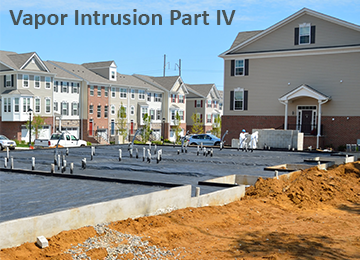Over the last several months, we’ve talked about volatile organic compounds (VOCs), how they move through soil and enter buildings, and why these compounds are a concern. So now that I have you sweating, relax! There’s a way for us to check your existing building and/or vacant property to see if there is a vapor intrusion concern. Federal (U.S. EPA) and some states have developed a regulatory framework to help consultants (such as ECS) start to decipher if your property has a potential problem. North Carolina has a fairly developed program, whereas South Carolina, Virginia, and Georgia default to U.S. EPA guidance. There are subtle differences, but even programs like North Carolina have their roots in U.S. EPA program.
These programs have acceptable action levels or screening levels (vapor intrusion screening levels or VISLs) for the various VOCs we have been talking about. Typically, they have a VISL for VOCs in groundwater, beneath or near the slab of a building, as well as inside the building: a/k/a, indoor air. If the atmosphere in these environments is collected and tested and is above its respective VISL, then there is a potential vapor intrusion issue. In the case of indoor air, the problem may already exist.
Though it may seem counter-intuitive, we typically start looking for vapor intrusion issues starting with the groundwater and working our way up and into the building. This way we can determine if the issue inside a building (assuming there is one) is coming from Vic and his friends below or from something you are using inside your building. The scary thing is that vapors come from all types of substances in the air we breathe, so we want to make sure the problem is really coming from “below” and not from the guy’s suit that was just dry-cleaned or the diesel on the shoes of the person who filled his car up this morning. Yep, these analyses look for VOCs into the parts per billion.
So how do we collect these samples? Well, it’s simple really, but we have to be very careful that we are collecting samples from where Vic and his friends are lurking. If data from groundwater samples indicates a potential vapor intrusion issue, then we collect sub-slab samples or samples outside the building (exterior samples) near the foundation of the building. The sub-slab samples are just that. We find a location inside your building (preferably not the lobby of the Class A office building), drill a small hole (about 3/8 inch diameter) through the concrete floor slab, and insert a probe (tube) down into the gravel below the slab. The hole has to be sealed (we don’t want yucky air in the building going down into the hole and giving us a false positive). We do a quality check to make sure we have a good seal. We also check the various connections between the probe and the canister being used to collect the sample. If we have missed threads, or there’s a loose fitting in our connections, that indoor air goes right in. Instead of collecting a sample from below the slab, the sample is from air above the slab. We think we are all clean, but I’ve got this strange rash…
Exterior samples are collected in a similar fashion, just deeper (we want to make sure no air is short circuiting through the soil into your probe). The samples are generally collected in a Summa Canister (some of these look like stainless steel bombs) or a Tedlar bag. The Summa Canister arrives from the lab under a vacuum. When it’s connected to the probe and opened up, in goes Vic and his friends. Pretty cool, right? The valves are closed, the canisters are labeled and shipped to the laboratory for analysis, the holes are sealed, and the waiting begins. The results from the laboratory are compared to the VISLs by the consultant, and we see what, if any, VOCs are above their respective VISL or not. Based on the results, the consultant may recommend no additional action is required, or maybe some modeling of the building needs to be performed. Indoor air sampling is very tricky and is usually conducted as a last resort.
If the soil gas investigation determines there is a vapor intrusion concern, then generally some type of mitigation will be required to keep the Vic and his friend out of your space. More on that next month.
Read the Series:
Who Is Intruding My Space? Vapor Intrusion, Part II
Bye, Bye VIC, Vapor Intrusion Part V
About the Author: John Stewart, PG, CPG
Mr. Stewart is a Chief Geologist for ECS. He has conducted hydrogeologic site investigations at a variety of sites including NCDOT Right-of-Way corridors, Brownfields properties, landfills, industrial sites including textile and furniture plants, machine shops, chemical manufacturing plants, commercial shopping facilities, dry cleaners, and gasoline stations.

